
The Silence of the Lambs is a 1991 American psychological horror thriller film directed by Jonathan Demme and written by Ted Tally, adapted from Thomas Harris's 1988 novel of the same name. It stars Jodie Foster as Clarice Starling, a young FBI trainee who is hunting a serial killer named "Buffalo Bill", who skins his female victims. To catch him, she seeks the advice of the imprisoned Dr. Hannibal Lecter, a brilliant psychiatrist and cannibalistic serial killer. The film also features performances from Scott Glenn, Anthony Heald, and Kasi Lemmons.

Dr. Hannibal Lecter is a character created by the American novelist Thomas Harris. Lecter is a serial killer who eats his victims. Before his capture, he was a respected forensic psychiatrist; after his incarceration, he is consulted by FBI agents Will Graham and Clarice Starling to help them find other serial killers.
William Thomas Harris III is an American writer, best known for a series of suspense novels about his most famous character, Hannibal Lecter. The majority of his works have been adapted into films and television, most notably The Silence of the Lambs, which became only the third film in Academy Awards history to sweep the Oscars in all of the five major categories.

Manhunter is a 1986 American thriller film directed and written by Michael Mann. Based on the 1981 novel Red Dragon by Thomas Harris, it stars William Petersen as FBI profiler Will Graham. Also featured are Tom Noonan as serial killer Francis Dollarhyde, Dennis Farina as Graham's FBI superior Jack Crawford, and Brian Cox as incarcerated killer Hannibal Lecktor. The film focuses on Graham coming out of retirement to lend his talents to an investigation on Dollarhyde, a killer known as the Tooth Fairy. In doing so, he must confront the demons of his past and meet with Lecktor, who nearly killed Graham.
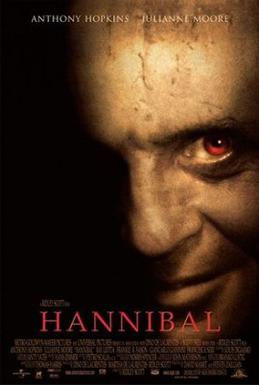
Hannibal is a 2001 American psychological horror crime thriller film directed by Ridley Scott and based on the 1999 novel by Thomas Harris. A sequel to the 1991 film The Silence of the Lambs, the plot follows disgraced FBI special agent Clarice Starling as she attempts to apprehend cannibalistic serial killer Hannibal Lecter before his surviving victim, Mason Verger, captures him. Anthony Hopkins reprises his role as Lecter, while Julianne Moore replaces Jodie Foster as Starling and Gary Oldman plays Verger. Ray Liotta, Frankie R. Faison, Giancarlo Giannini, and Francesca Neri also star.
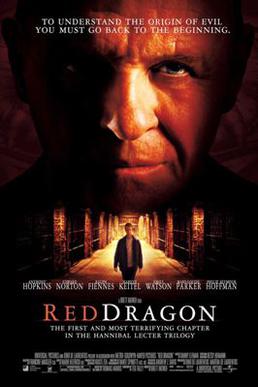
Red Dragon is a 2002 psychological thriller film based on the 1981 novel by Thomas Harris. It was directed by Brett Ratner and written by Ted Tally. It is the third film of the Dino De Laurentiis Company production, last produced by Universal Pictures, and last starred by actor Anthony Hopkins. It follows The Silence of the Lambs (1991) and Hannibal (2001) as a prequel, being followed by Hannibal Rising (2007). The film sees FBI agent Will Graham enlisting the help of serial killer Hannibal Lecter to catch another killer, Francis Dolarhyde. Harvey Keitel, Emily Watson, Mary-Louise Parker, and Philip Seymour Hoffman also star.
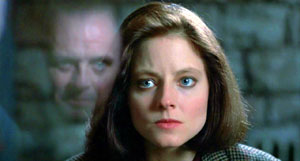
Clarice M. Starling is a fictional character and protagonist of the novels The Silence of the Lambs (1988) and Hannibal (1999) by Thomas Harris.

Jack Crawford is a fictional character who appears in the Hannibal Lecter series of novels by Thomas Harris, in which Crawford is the Agent-in-Charge of the Behavioral Science Unit of the FBI in Quantico, Virginia. He is modeled after John E. Douglas, who held the same position.

Dr. Frederick Chilton is a fictional character appearing in Thomas Harris' novels Red Dragon (1981) and The Silence of the Lambs (1988), along with the film and television adaptations of Harris's novels.
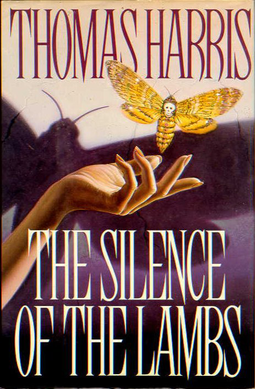
The Silence of the Lambs is a 1988 psychological horror novel by Thomas Harris. Published August 29, it is the sequel to Harris's 1981 novel Red Dragon and both novels feature the cannibalistic serial killer and brilliant psychiatrist Dr. Hannibal Lecter. This time, however, he is pitted against FBI trainee Clarice Starling as she works to solve the case of the "Buffalo Bill" serial killer.

Hannibal is a psychological horror novel by American author Thomas Harris, published in 1999. It is the third in his series featuring Dr. Hannibal Lecter and the second to feature FBI Special Agent Clarice Starling. The novel takes place seven years after the events of The Silence of the Lambs and deals with the intended revenge of one of Lecter's victims. It was adapted as a film of the same name in 2001, directed by Ridley Scott. Elements of the novel were incorporated into the second season of the NBC television series Hannibal, while the show's third season adapted the plot of the novel.

Red Dragon is a psychological horror novel by American author Thomas Harris, first published in 1981. The story follows former FBI profiler Will Graham, who comes out of retirement to find and apprehend an enigmatic serial killer nicknamed "the Tooth Fairy". The novel introduces the character Dr. Hannibal Lecter, a brilliant psychiatrist and cannibalistic serial killer whom Graham reluctantly turns to for advice and with whom he has a dark past.
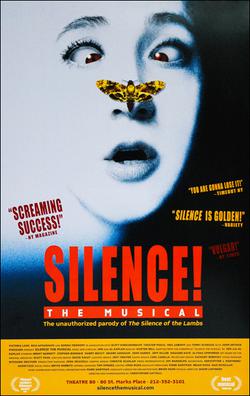
Silence! The Musical is a 2005 musical created by Jon Kaplan and Al Kaplan as a parody of the 1991 Academy Award-winning film The Silence of the Lambs, which is in turn based on 1988 novel of the same name by Thomas Harris. The musical is itself based on a parody screenplay of the same name written by Jon Kaplan and Al Kaplan.
Fictional portrayals of psychopaths, or sociopaths, are some of the most notorious in film and literature but may only vaguely or partly relate to the concept of psychopathy, which is itself used with varying definitions by mental health professionals, criminologists and others. The character may be identified as a diagnosed/assessed psychopath or sociopath within the fictional work itself, or by its creator when discussing their intentions with the work, which might be distinguished from opinions of audiences or critics based only on a character appearing to show traits or behaviors associated with an undefined popular stereotype of psychopathy.

The Hannibal Lecter franchise is an American media franchise based around the titular character, Hannibal Lecter, a brilliant, cannibalistic serial killer whose assistance is routinely sought out by law enforcement personnel to aid in the capture of other criminals. He originally appeared in a series of novels by Thomas Harris. The series has since expanded into film and television, having four timeline-connected franchise films produced by Dino De Laurentiis Company: The Silence of the Lambs (1991), Hannibal (2001), Red Dragon (2002) and Hannibal Rising (2007), with three starring Anthony Hopkins.

Mason Verger is a fictional character and the main antagonist of Thomas Harris's 1999 novel Hannibal, as well as its 2001 film adaptation and the second and third seasons of the TV series Hannibal. In the film, he is portrayed by Gary Oldman, while in the TV series he is portrayed by Michael Pitt and Joe Anderson.

Darla (1975–1992) was a Bichon Frise best known for her acting role as Precious in the 1991 thriller The Silence of the Lambs, a film which earned the Big Five Academy Awards. Darla acted in several other films, including Batman Returns (1992).

Will Graham is a fictional character and protagonist of Thomas Harris' 1981 novel Red Dragon. Graham is also the protagonist of two film adaptations of the novel, Manhunter (1986) and Red Dragon (2002), and the television series Hannibal (2013–2015), which adapted various parts of the Hannibal Lecter franchise.
"Fromage" is the eighth episode of the first season of the psychological thriller–horror series Hannibal. The episode was written by producer Jennifer Schuur and series creator Bryan Fuller, and directed by Tim Hunter. It was first broadcast on May 16, 2013, on NBC.
"Kaiseki" is the first episode of the second season of the psychological thriller–horror series Hannibal. It is the 14th overall episode of the series and was written by series creator Bryan Fuller and executive producer Steve Lightfoot, and directed by Tim Hunter. It was first broadcast on February 28, 2014, on NBC.















